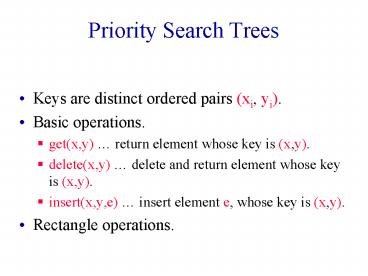Priority Search Trees - PowerPoint PPT Presentation
Title:
Priority Search Trees
Description:
Priority Search Trees. Keys are distinct ordered pairs (xi, yi). Basic ... delete and return element whose key is ... translucent lines. Translucent Lines ... – PowerPoint PPT presentation
Number of Views:280
Avg rating:3.0/5.0
Title: Priority Search Trees
1
Priority Search Trees
- Keys are distinct ordered pairs (xi, yi).
- Basic operations.
- get(x,y) return element whose key is (x,y).
- delete(x,y) delete and return element whose key
is (x,y). - insert(x,y,e) insert element e, whose key is
(x,y). - Rectangle operations.
2
minXinRectangle(xL,xR,yT)
- Return element with min x-coordinate in the
rectangle defined by the lines, x xL, x xR, y
0, y yT, xL lt xR, 0 lt yT.
- I.e., return element with min x such that
- xL lt x lt xR and 0 lt y lt yT.
3
maxXinRectangle(xL,xR,yT)
- Return element with max x-coordinate in the
rectangle defined by the lines, x xL, x xR, y
0, y yT, xL lt xR, 0 lt yT.
- I.e., return element with max x such that
- xL lt x lt xR and 0 lt y lt yT.
4
minYinXrange(xL,xR)
- Return element with min y-coordinate in the
rectangle defined by the lines, x xL, x xR, y
0, y infinity, xL lt xR.
- I.e., return element with min y such that
- xL lt x lt xR.
5
enumerateRectangle(xL,xR,yT)
- Return all elements in the rectangle defined by
the lines, x xL, x xR, y 0, y yT, xL lt xR,
0 lt yT.
- I.e., return all elements such that
- xL lt x lt xR and 0 lt y lt yT.
6
Complexity
- O(log n) for each operation except for
enumerateRectangle, where n is the number of
elements in the tree. - Complexity of enumerateRectangle is O(log n
s), where s is the number of elements in the
rectangle.
7
Applications Visibility
- Dynamic set of semi-infinite vertical line
segments. - Vertical lines with end points (xi,infinity) and
(xi,yi).
Opaque/translucent lines.
8
Translucent Lines
- Eye is at (x,y).
- Priority search tree of line end points.
- enumerateRectangle(x, infinity, y).
9
Opaque Lines
- Eye is at (x,y).
- Priority search tree of line end points.
- minXinRectangle(x, infinity, y).
10
Bin Packing
- First fit.
- Best fit.
- Combination.
- Some items packed using first fit.
- Others packed using best fit.
- Memory allocation.
11
Combined First And Best Fit
- Bins are numbered 0, 1, , n 1.
- Capacity of each is c.
- Initialize priority search tree with the pairs
(c, j), 0 lt j lt n.
12
First Fit
- minYinXrange(neededSize, infinity)
13
Best Fit
- minXinRectangle(neededSize, infinity, infinity)
14
Online Intersection Of Line Intervals
- Intervals are of the form i,j, i lt j.
- i,j may, for example represent the fact that a
machine is busy from time i to time j. - Answer queries of the form which intervals
intersect/overlap with a given interval u,v,
u lt v. - List all machines that are busy at any time
between u and v.
15
Example
- Machine a is busy from time 1 to time 3.
- Interval is 1,3.
- Machines a, b, c, e, and f are busy at some time
in the interval 2,4.
16
Example
- Interval i,j corresponds to the pair (x,y),
where x j and y i.
- enumerateRectangle(u, infinity, v).
- enumerateRectangle(2, infinity, 4).
17
Compare With Segment Tree
- Min and max interval end points must be known in
advance to define the root range of the segment
tree. - Search interval size is 1.
- Must break larger search intervals into unit
intervals and remove duplicate responses.
18
Interval Containment
- List all intervals i,j that contain the
interval u,v. - i,j contains u,v iff i lt u lt v lt j.
u,v 5,6
19
Interval Containment
- Interval i,j corresponds to the pair (x,y),
where x j and y i.
- enumerateRectangle(v, infinity, u).
- enumerateRectangle(6, infinity, 5).
20
Intersecting Rectangle Pairs
- (A,B), (A,C), (D, G), (E,F)
- Online interval intersection.
21
Algorithm
- Examine horizontal edges in sorted y order.
- Bottom edge gt insert interval into a priority
search tree. - Top edge gt report intersecting segments and
delete the top edges corresponding bottom edge.
22
Complexity
- Examine edges in sorted order.
- Bottom edge gt insert interval into a priority
search tree. - Top edge gt report intersecting segments and
delete the top edges corresponding bottom edge.
- O(n log n) to sort edges by y, where n is of
rectangles. - Insert n intervals O(n log n).
- Report intersecting segments O(n log n s).
- Delete n intervals O(n log n).
23
IP Router Table
- Longest-prefix matching
- 10, 101, 1001
- Destination address d 10100
- Longest matching-prefix is 101
- Prefix is an interval
- d is 5 bits gt 101 10100, 10111 20,23
- 2 prefixes may nest but may not have a proper
intersection
24
IP Router Table
- p(d) prefixes that match d.
- Use online interval intersection mapping.
- p(d) enumerateRectangle(d,infinity,d)
25
IP Router Table
- lmp(d) maxStart(p(d)), minFinish(p(d))
- minXinRectangle(d,infinity,d) finds lmp(d) except
when gt1 prefixes have same finish point.
26
IP Router Table
- Remap finish points so that all prefixes have
different finish point. - f 2wf s 2w 1 , w length of d
- f is smaller when s is bigger
27
IP Router Table
- Complexity is O(log n) for insert, delete, and
find longest matching-prefix.































